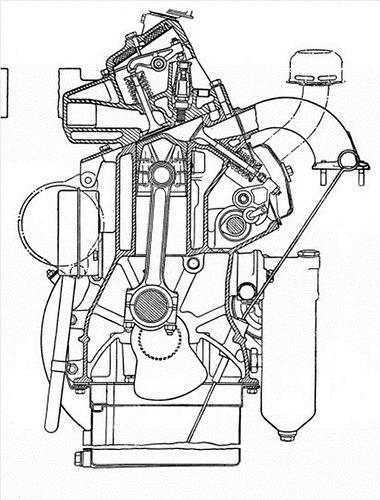
Originally Posted by
JDNSW

The 'F' head was used for various reasons by different manufacturers and at different times.
In early engines, with non-detachable cylinder heads, overhead valves meant you had to remove the block to do a valve grind - and in those days valve grinds were frequently well under 1,000miles. This rapidly led to the popularity of side valve engines, where you could have a removable pug above each valve, one of which usually sported the spark plug. But this meant the inlet and outlet valves were competing for space both for the valves and their manifolds etc. You could have them on opposite sides, and some did, but this meant two camshafts with all the costs of that.
Manufacturers rapidly woke up to the fact that you could put the inlet valve in the plug above the exhaust, enabling you to have both valves larger, and separating the manifolds more easily. This is the setup I first encountered, with a Reo from the early twenties.
As detachable heads became more popular from Edwardian times onward, the layout became a popular scheme particularly for UK manufacturers, where the use of RAC HP rating for tax purposes encouraged long stroke engines. The corollary of long stroke is small bore, which means lack of space for valves regardless of whether you put them both alongside or both in the head. So quite a few did both, as far as I am aware, invariably with the exhaust side and inlet overhead.
Rover's unique design, by thinking outside the square and having a tilted junction between the head and the block, with the combustion chamber shape defined by the shape of the block around the exhaust and the top of the piston, was able to achieve what is effectively a a crossflow hemispherical combustion chamber as well as the turbulent mixing from the piston to head clearance of almost zero for half the piston area.
The Willys engine is an interesting case. Faced with the need for a more modern engine as the US awoke in the 1950s to the fact that the rest of the world was mostly using overhead valves, but lacking in capital, they managed to convert their 1930s side valve engine into an IOE engine and retain the same block casting, as well as quite a few other bits. I doubt the fact that the Landrover had used an IOE engine since its inception had anything to do with it - Willys was probably only marginally aware of the Landrover's existence, justifiably, in one sense, as there was little trade between dollar and sterling currency areas.
fheadr by john smith, on Flickr
fheadl by john smith, on Flickr
F-head-RR-B60 by john smith, on Flickr
rolls royce B81 by john smith, on Flickr
B81 head gasket by john smith, on Flickr



 Reply With Quote
Reply With Quote





Bookmarks